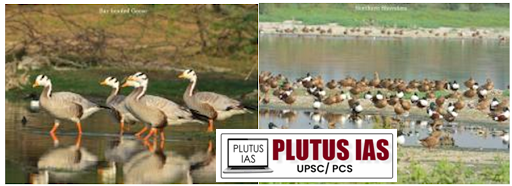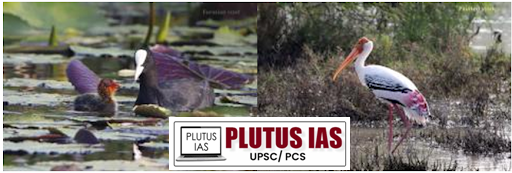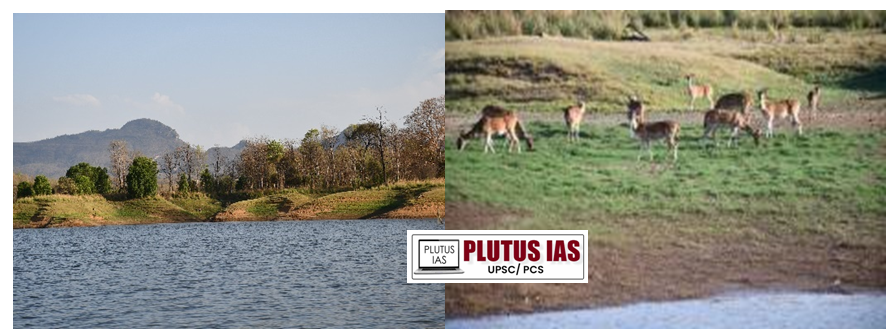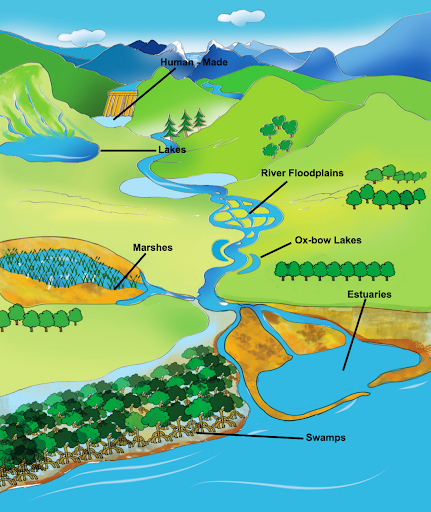17 Aug Wetlands: Nature’s Shield Against Climate Change Impacts
“Wetlands: Nature’s Shield Against Climate Change Impacts”
This article covers “Daily Current Affairs” and details the new protected areas added to the Ramsar sites.
Syllabus mapping:
GS- 3: Environment conservation: Protected areas and pollution
For Prelims:
This topic is important very very important. Take note of all three new wetland sites
How to study Protected Areas: Location, species diversity, rivers, city, and any other ecotourism advancement
For Mains:
What is Ramsar convention and what is the wise use of wetlands?
what are the threats, measures, and recommendations to protect the wetlands?
Why In the News?
Union Environment Minister Shri Bhupender Yadav says India adds 3 more wetlands to the list of Ramsar sites on the eve of Independence Day 2024. With this addition, the tally of Ramsar sites touches 85 covering an area of 1358068 ha in the country. Three new sites included are Nanjarayan Bird Sanctuary Kazhuveli Bird Sanctuary in Tamil Nadu and Tawa Reservoir in Madhya Pradesh. The country has added 59 new wetlands to the list of Ramsar sites during 2014-2024.
What is the Ramsar Convention?
The Ramsar Convention, officially known as the Convention on Wetlands of International Importance Especially as Waterfowl Habitat, is an international treaty aimed at the conservation and sustainable use of wetlands around the world.
Origins:
Signed: The convention was adopted in Ramsar, Iran, on February 2, 1971.
International Wetland Day: Feb 2 every year.
Implementation:
Operational: The Ramsar Convention officially came into force on December 21, 1975.
Global Reach: As of now, it includes over 170 Contracting Parties (countries), with over 2,400 Ramsar Sites designated worldwide
Primary Goals:
1. Conservation: The Ramsar Convention seeks to ensure the conservation of wetlands, which are vital for maintaining biodiversity, regulating water cycles, and providing ecosystem services.
2. Sustainable Use: It promotes the sustainable use of wetlands, balancing ecological health with human needs.
What is the relationship between the Ramsar Convention and India?
India’s Involvement: India is a Contracting Party to the Ramsar Convention, having signed it in 1971 and become a signatory on 1st February 1982.
Historical Additions: From 1982 to 2013, India added 26 Ramsar sites.
Recent Additions: Between 2014 and 2024, India added 59 new Ramsar sites, reflecting a significant policy push towards wetlands conservation.
What are the Recent Developments in Wetlands Conservation and Ramsar Site Designation?
New Ramsar Sites: Three new wetlands have been added to India’s Ramsar site list:
Nanjarayan Bird Sanctuary (Tamil Nadu) – Designated on 16.01.2024, covering 125.865 hectares.
Kazhuveli Bird Sanctuary (Tamil Nadu) – Designated on 16.01.2024, covering 5,151.6 hectares.
Tawa Reservoir (Madhya Pradesh) – Designated on 08.01.2024, covering 20,050 hectares.
Total Area: Current Total Area of Ramsar Sites: The addition of these sites brings the total area of Ramsar sites in India to 1,358,067.757 hectares.
Top States:
Tamil Nadu: Now hosts the largest number of Ramsar sites in India, with a total of 18 sites.
Uttar Pradesh: Follows with 10 Ramsar sites.
Nanjarayan Bird Sanctuary (Tamil Nadu)
Geographic Position: Nanjarayan Lake is situated in the northeastern region of Uthukuli Taluk, Tiruppur District, Tamil Nadu.
 Bar-headed Goose Flock of Northern Shoveler
Bar-headed Goose Flock of Northern Shoveler
Area: Spans approximately 125.865 hectares.
Historical Context: The lake is named after King Nanjarayan, who repaired and restored it centuries ago. This historical association underscores the lake’s long-standing importance to the region.
Ecological and Biodiversity Features
Avifauna: Hosts around 191 species of birds, making it a crucial habitat for both resident and migratory bird species.
Butterflies: Home to 87 species, contributing to the region’s rich lepidopteran diversity.
Amphibians: Contains 7 species, indicating a healthy aquatic ecosystem.
Reptiles: Features 21 species, including various important ecological roles.
Small Mammals: Includes 11 species, adding to the biodiversity of the area.
Flora: Supports 77 species of plants, which are integral to the ecosystem.
Ecological Functions:
Feeding and Nesting Habitat: Acts as a critical feeding and nesting ground for both resident and migratory birds, highlighting its importance for avian species.
Water Source: Provides an essential water source for local agriculture, supporting the livelihoods of the surrounding communities.
Ground Water Recharge: Plays a significant role in replenishing groundwater levels, crucial for sustaining local water supplies.
Protected Area Status:
Bird Sanctuary: Designated as the 17th bird sanctuary in Tamil Nadu due to its significant avifaunal diversity.
Kazhuveli Bird Sanctuary (Tamil Nadu)
Geographic Position: Kazhuveli Bird Sanctuary is situated on the Coromandel Coast in Villupuram District, Tamil Nadu, to the north of Pondicherry. Eurasian Coot with its juvenile Painted Stork
Eurasian Coot with its juvenile Painted Stork
Accessibility: The lake is connected to the Bay of Bengal via the brackish Uppukalli Creek and the Edayanthittu Estuary.
Area: Spans 5151.6 hectares, making it one of the largest wetlands in peninsular India.
Designation: Declared as the 16th bird sanctuary in Tamil Nadu in 2021, reflecting its ecological significance.
Ecological and Biodiversity Features
Estuarine Brackish Water: The estuarine part of the lake has brackish water, influenced by its connection to the sea.
Uppukalli Creek: Feeds seawater into the lake, affecting its salinity and ecological dynamics.
Kazhuveli Basin: Contains freshwater, which supports diverse aquatic life and vegetation.
Biodiversity:
Avian Species: Located in the Central Asian Flyway, Kazhuveli serves as an important stopover for migratory bird species. It also functions as a breeding ground for resident bird species.
Fish Breeding: The sanctuary provides critical breeding grounds for various fish species.
Vegetation:
Mangroves: Features degraded mangrove patches, primarily containing Avicennia species.
Reed Beds: Extensive areas of reed beds (Typha angustata) are found, contributing to the wetland’s ecological complexity.
Historical Vegetation: Previously supported Tropical Dry Evergreen Forests, indicating a rich historical ecological past.
Ecological Significance:
Stopover for Migratory Birds: Acts as a crucial stopover site for birds migrating along the Central Asian Flyway, highlighting its importance in global bird migration patterns.
Breeding Ground: Provides essential breeding grounds for both resident and migratory bird species.
Aquifer Recharge: Serves as a major recharge source for local aquifers, supporting groundwater sustainability.
Tawa Reservoir (Madhya Pradesh)
Location: Backwater of Tawa Reservoir Spotted dear in Tawa Reservoir
Backwater of Tawa Reservoir Spotted dear in Tawa Reservoir
Geographic Position: The Tawa Reservoir is situated at the confluence of the Tawa and Denwa rivers, near Itarsi town in Madhya Pradesh.
Catchment Area: The reservoir has a catchment area of 598,290 hectares.
Submergence Area: Covers a total area of 20,050 hectares.
River System:
Tawa River: Originates from the Mahadeo Hills in the Chhindwara district, flows through the Betul district, and joins the Narmada River in the Narmadapuram district. It is the longest tributary of the Narmada River, with a length of 172 km.
Major Tributaries: Includes the Malani, Sonbhadra, and Nagdwari rivers.
Construction Purpose:
Primary Use: Originally constructed primarily for irrigation purposes.
Additional Uses: Now also utilized for power generation and aquaculture.
Ecological and Biodiversity Features
Aquatic Flora and Fauna: Supports a diverse range of aquatic plants and animals. Important for the ecological balance of the region.
Bird Habitat: Serves as a critical habitat for both local and migratory bird species.
Wildlife: The reservoir area is home to many rare and endangered species of plants, reptiles, and insects.
Protected Areas:
Satpura Tiger Reserve: The reservoir is located within the Satpura Tiger Reserve, forming the western boundary of both the Satpura National Park and the Bori Wildlife Sanctuary.
Conservation Importance: Being part of a larger protected area, the reservoir plays a vital role in the conservation of regional biodiversity.
Ecological Importance:
Habitat for Wildlife: Provides critical habitat for a variety of species, contributing to the overall health of the ecosystem.
Biodiversity Hotspot: The region’s unique features from ecological, archaeological, historical, and forestry perspectives enhance its importance as a biodiversity hotspot.
Socioeconomic Impact:
Irrigation: Plays a crucial role in supporting agricultural activities in the region.
Power Generation: Contributes to regional energy needs through hydroelectric power generation.
Aquaculture: Supports local fisheries and provides economic benefits through fish production.
What are the wetlands?
Definition: “Areas of marsh, fen, peatland or water, whether natural or artificial, permanent or temporary, with water that is static or flowing, fresh, brackish or salt, including areas of marine water the depth of which at low tides does not exceed six meters.”
Article 2.1: Wetlands may also include:
Riparian and Coastal Zones: Adjacent areas that are closely connected to the wetlands.
Islands or Marine Bodies: Bodies of marine water deeper than six meters at low tide that lie within the wetlands.
Types of Wetland:
Human-Made Wetlands
1. Reservoirs: Created for storing water for purposes such as irrigation, drinking, and hydroelectric power.
Examples: Bhakra Nangal Reservoir, and Nagarjuna Sagar Reservoir.
2. Aquaculture Ponds: Designed for farming aquatic organisms such as fish, shellfish, and algae.
Examples: Ponds used in shrimp farming or fish farms.
3. Salt Pans: Used for evaporating seawater to produce salt.
Examples: Salt pans in the Rann of Kutch.
4. Dams and Barrages: Built to regulate river flow, store water, and generate hydroelectric power.
Examples: The Hoover Dam, and Tehri Dam.
5. Impoundments: Areas where water is temporarily or permanently held back, typically by barriers or natural formations.
Examples: Small water bodies created by barriers in streams or rivers.

Credit: MOEFCC.
Natural Wetlands
1. Lakes: Inland freshwater bodies that are relatively stationary. Provide habitats for aquatic and terrestrial life; source of freshwater.
Examples: Dal Lake in Jammu and Kashmir, and Vembanad Lake in Kerala.
2. River Floodplains: Lands adjacent to rivers or streams subject to periodic inundation. Support rich biodiversity; crucial for agriculture and water resources.
Examples: Yamuna Floodplains in Delhi, Mississippi River Floodplain in the USA.
3. Ox-Bow Lakes: Crescent-shaped lakes formed when a meander of a river is cut off. Provide unique habitats and play a role in sediment deposition.
Examples: Ansupa Lake in the Mahanadi Delta, and numerous ox-bow lakes in the Ganga-Brahmaputra basin.
4. Marshes: Wetlands dominated by herbaceous plants with water sources other than direct rainfall. Support diverse plant and animal species; help in water filtration and flood regulation.
Examples: Kanwar Jheel (Kabar Tal) in Bihar, Everglades in the USA.
5. Estuaries: Partially enclosed coastal bodies where freshwater from rivers meets saltwater from the sea. Support rich biodiversity; serve as nurseries for marine life.
Examples: Chilika Lake in Odisha, and San Francisco Bay in the USA.
6. Swamps: Wetlands dominated by trees, with poor drainage and waterlogged conditions. Provide habitat for a variety of species; play a role in carbon sequestration.
Examples: Sundarbans Mangrove Swamp in India and Bangladesh, Okavango Delta in Botswana.
What are the benefits offered by the Wetlands?
Wetlands offer a wide range of values and benefits that are essential to both ecosystems and human societies.
1. Wetlands as a Source of Water
Freshwater Supply: Wetlands, such as lakes, rivers, and floodplains, act as natural reservoirs, providing a critical source of freshwater for drinking, irrigation, and industrial use.
Groundwater Recharge: Wetlands help replenish groundwater supplies by allowing water to seep into aquifers, ensuring sustainable water resources for surrounding areas.
2. Wetlands as Flood and Storm Buffers
Flood Mitigation: Wetlands absorb excess rainwater and river flow, reducing the impact of floods by storing and slowly releasing water.
Storm Protection: Coastal wetlands like mangroves and salt marshes act as natural barriers, reducing the impact of storm surges and protecting coastal communities from erosion and damage.
3. Wetland Products
Natural Resources: Wetlands provide resources such as fish, shellfish, reeds, and other plants used for food, construction, and traditional crafts.
Economic Value: Products from wetlands contribute to local economies through fishing, harvesting, and tourism.
4. Wetlands as Water Purifiers
Filtration: Wetlands filter pollutants from water through natural processes. Plants and microorganisms break down contaminants and trap sediments, improving water quality.
Wastewater Treatment: Constructed wetlands are used in wastewater treatment systems to remove pollutants and enhance water purification.
5. Wetlands for Recreation and Tourism
Eco-Tourism: Wetlands offer opportunities for eco-tourism activities such as bird watching, fishing, and boating. They attract visitors who appreciate their natural beauty and wildlife.
Recreational Activities: Wetlands provide spaces for recreational activities like kayaking, hiking, and nature photography, contributing to human well-being and leisure.
6. Wetlands for Education and Research
Scientific Study: Wetlands serve as important sites for research on ecology, hydrology, and environmental science. They offer insights into ecological processes and the impacts of climate change.
Educational Opportunities: Wetlands provide educational experiences for students and the public, fostering awareness and understanding of environmental conservation and biodiversity.
7. Wetlands and Climate Change
Carbon Sequestration: Wetlands, especially peatlands and mangroves, act as carbon sinks, storing large amounts of carbon dioxide and helping to mitigate climate change.
Climate Regulation: By regulating local and regional climate conditions, wetlands influence temperature, humidity, and weather patterns.
8. Wetlands as Habitats for Migratory Birds
Stopover Sites: Wetlands serve as critical stopover points for migratory birds, offering food and rest during long journeys.
Breeding Grounds: Many wetlands provide essential breeding and nesting habitats for various bird species, contributing to their conservation and population stability.
9. Wetlands as Biodiversity Hotspots
Species Diversity: Wetlands support a rich array of plant and animal species, many of which are specialized to wetland environments.
Habitat Connectivity: They connect different ecosystems, allowing for the movement and migration of species, which is crucial for maintaining biodiversity and ecological health.
“What threats do wetlands face?
1. Alteration of Natural Hydrological Regimes: Changes to the natural flow of water into and out of wetlands due to activities such as dam construction, river diversion, and land drainage.
Impacts:
Reduced Water Flow: Alters the quantity and timing of water flow, affecting wetland hydrology and habitat conditions.
Ecosystem Disruption: This can lead to changes in plant and animal communities, reducing biodiversity and altering ecosystem functions.
Sediment Accumulation: Alters sediment deposition patterns, impacting water quality and habitat structure.
2. Catchment Degradation: Degradation of the land area that drains into a wetland, often due to deforestation, agriculture, or urban development.
Impacts:
Increased Runoff: This leads to higher volumes of surface runoff carrying sediments and pollutants into wetlands.
Erosion and Sedimentation: Accelerated soil erosion and sedimentation can alter wetland morphology and degrade habitats.
Loss of Buffer Zones: Reduction in natural vegetation around wetlands decreases their ability to filter pollutants and manage water flow.
3. Pollution: Contamination of wetland waters and soils by pollutants such as chemicals, heavy metals, nutrients, and pathogens from agricultural runoff, industrial discharges, and sewage.
Impacts:
Water Quality Degradation: Pollutants can reduce oxygen levels, harm aquatic life, and lead to algal blooms.
Health Risks: Contaminated water poses risks to human health and wildlife.
Ecosystem Imbalance: Disruption of nutrient cycles and harmful effects on plant and animal species.
4. Invasive Species: Non-native plant or animal species that establish themselves in wetlands, often outcompeting native species.
Impacts:
Competition for Resources: Invasive species can dominate resources such as nutrients, light, and space, displacing native species.
Altered Ecosystem Functions: Changes in species composition can affect nutrient cycling, water quality, and habitat structure.
Decreased Biodiversity: Reduction in native species diversity and loss of ecosystem resilience.
5. Over-Harvesting of Resources: Unsustainable extraction of wetland resources such as fish, plants, and other natural products.
Impacts:
Resource Depletion: Over-harvesting can lead to the decline of valuable species and disrupt food chains.
Ecosystem Disruption: Changes in species populations can impact ecosystem functions and services.
Economic Impact: Depletion of resources can affect local communities dependent on wetlands for livelihood.
6. Unregulated Tourism: Tourism activities in wetlands that are not properly managed or regulated.
Impacts:
Habitat Disturbance: Physical disturbance from tourists, including trampling and construction, can damage sensitive habitats.
Pollution and Waste: Increased waste and pollution from tourism can degrade water quality and harm wildlife.
Wildlife Disruption: Human activities can disturb nesting and breeding sites, affecting wildlife behavior and populations.
7. Climate Change: Long-term changes in climate patterns, including rising temperatures, altered precipitation, and sea level rise, affect wetland environments.
Impacts:
Temperature Changes: Altered temperatures can affect species distributions and ecosystem functions.
Sea Level Rise: In coastal areas, rising sea levels can lead to the loss of wetlands through inundation and increased salinity.
Changing Precipitation Patterns: Variability in rainfall can impact water levels, wetland hydrology, and habitat availability.
“How is the Government of India protecting wetlands?
The Government of India has implemented several key programs and initiatives to protect and manage wetlands effectively.
1. Amrit Dharohar (June 2023): To promote the conservation values of Ramsar Sites, while also creating job opportunities and supporting local livelihoods.
Implementation: This initiative involves collaboration with various government ministries and agencies, state wetland authorities, and other stakeholders.
Key Components: Enhancing the ecological and economic value of Ramsar Sites by integrating conservation efforts with community development.
2. Wetlands Rejuvenation Programme (2020)
Objective: To address the degradation of wetlands through comprehensive management and restoration efforts.
Key Activities:
Baseline Data: Developing comprehensive data on wetland conditions and health.
Health Assessment: Evaluating the ecological status of wetlands.
Stakeholder Platforms: Establishing forums for stakeholder engagement and collaboration.
Management Plans: Creating and implementing plans for effective wetland management.
3. National Wildlife Action Plan (2017–2031)
Objective: To conserve wildlife and their habitats, including inland aquatic ecosystems and wetlands.
Focus Areas:
Inland Aquatic Ecosystems: Specific strategies for the conservation of wetlands and related habitats.
National Wetlands Mission: Advocating for a dedicated mission to preserve wetland ecosystems.
4. National Plan for Conservation of Aquatic Ecosystems (2013)
Objective: To integrate the conservation efforts for lakes and wetlands into a unified approach.
Formation: Created by merging the National Wetlands Conservation Programme and the National Lake Conservation Plan.
Key Focus: Conservation and sustainable management of aquatic ecosystems across India.
5. Save Wetlands Campaign (Three-Year Initiative)
Objective: To raise public awareness and foster a movement for wetland conservation.
Components:
Species and Habitat Conservation: Protecting wetland species and their habitats.
Wetlands Livelihoods: Promoting sustainable livelihoods linked to wetlands.
Nature Tourism: Encouraging eco-friendly tourism practices.
Wetlands Carbon: Addressing carbon sequestration and climate change impacts.
6. Wetlands (Conservation and Management) Rules, 2017
Objective: To regulate activities within wetlands to prevent degradation and ensure sustainable use.
Key Provisions:
Activity Regulation: Rules for managing human activities that affect wetlands.
Conservation Measures: Guidelines for maintaining wetland health and biodiversity.
7. National Biodiversity Action Plan
Objective: To protect and sustainably manage biodiversity, including wetlands.
Strategies:
Wetland Conservation: Specific actions for the conservation of wetland biodiversity.
Sustainable Management: Promoting practices that balance ecological health with human needs.
What are the recommendations and Expert suggestions for the protection and sustainability of wetlands in India?
1. Task Force on Wetlands Conservation (2018)
Wetland Identification: Updating the list of wetlands and prioritizing their conservation based on ecological significance.
Regulation and Enforcement: Stricter enforcement of regulations related to wetland conservation and management.
Funding and Incentives: Increased funding and financial incentives for wetland conservation projects and activities.
2. National Plan for Conservation of Aquatic Ecosystems (NPCA) Committee (2013)
Unified Approach: Integrating wetland and lake conservation efforts into a single approach.
Comprehensive Management: Comprehensive management plans addressing both ecological and socio-economic aspects.
Monitoring and Evaluation: Regular monitoring and evaluation to assess conservation effectiveness.
3. National Biodiversity Action Plan (NBAP) Committee (2008)
Integrated Management: Integrated approach to wetland management that includes conservation and development needs.
Research and Capacity Building: Enhancing research and capacity for effective wetland management.
4. Parliamentary Standing Committee on Environment and Forests (2007)
Coordination: Better coordination among government agencies and stakeholders.
Awareness Programs: Public awareness campaigns about the importance of wetlands.
5. National Lake Conservation Plan (NLCP) Committee (2001)
Restoration Projects: Focused on restoring lakes and wetlands through specific projects.
Public Participation: Active participation of local communities in conservation efforts.
Pollution Control: Measures to control pollution and manage urban runoff affecting wetlands.
6. National Wetlands Conservation Committee (NWCC) (1992)
Conservation Strategy: National strategy for wetland conservation, including Ramsar Sites.
Research and Monitoring: Regular research and monitoring to assess wetland health and threats.
Legislation and Policy: Strengthening legislation and policies for wetland protection.
7. Madhav Gadgil Committee (1991)
Conservation Priorities: Prioritized conservation of wetlands in the Western Ghats.
Integrated Management: Integrated approaches combining conservation with sustainable development.
Local Involvement: Encouraged involvement of local communities in conservation efforts.
8. Sukla Committee (1980)
Management Plans: Preparing management plans for wetlands.
Funding and Support: Ensuring adequate funding and support for wetland conservation.
Conclusion:
The recent addition of three more wetlands to the Ramsar list reinforces India’s commitment to the protection and conservation of the environment. The protection of Wetlands and other water bodies is essential for India to act against climate change and its impacts.
Download plutus ias current affairs eng med 17th Aug 2024
PRELIMS QUESTION:
Q.With reference to the Wetlands Conservation Rules 2010, Consider the following statement:
1. The Wetlands Conservation Rules made it obligatory for the state to prepare state-specific plans
2. The wetland conservation Rules prioritize the protection and conservation of inland wetlands over coastal wetlands
3. The Wetland Conservation Rules define what constitutes a Wetland
How many of the above-given statements are correct?
A. Only one
B. Only two
C. All three
D. None
ANSWER: B
MAINS QUESTION:
How do wetlands contribute to climate resilience and adaptation, and what are the potential challenges in implementing effective wetland conservation strategies? Illustrate with specific examples and suggest measures to enhance wetland conservation efforts.
(250 Words 15 marks)



No Comments